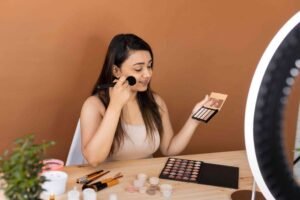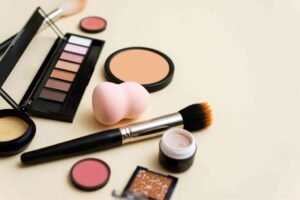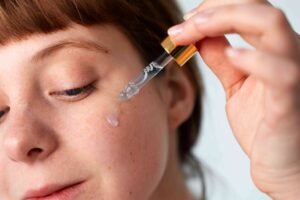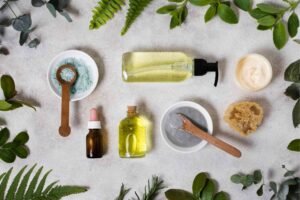How Endocrine Disruptors in Cosmetics Impact Your Hormones?
Let’s get real for a second: How often do you check the ingredients in your favorite shampoo, moisturizer, or lipstick? If your answer is “almost never,” you’re definitely not alone. Most of us don’t think twice about the lotions we slather on our skin or the body sprays we spritz every morning. But here’s the thing—some of those sweet-smelling, silky-feeling products might be hiding a dirty little secret: endocrine disruptors in cosmetics.
So let’s dive deep into what endocrine disruptors are, how they sneak into our beauty routines, and what that actually means for your health. Spoiler alert: It’s more than just a breakout or dry skin.

What Are Endocrine Disruptors?
Imagine your body’s hormone system aka your endocrine system, as a well-oiled orchestra. Every hormone has a role to play, and they all work in harmony to regulate your metabolism, sleep, mood, growth, sexual function, and more. Now picture someone barging in with a trumpet, playing totally off-key. That’s basically what endocrine disruptors do.
These are chemicals that can mimic, block, or interfere with hormones in the body. They might look like hormones to your body’s receptors, which can confuse your system and throw it off balance. And because hormones are all about communication and regulation, even a small disruption can have big consequences.
Common Endocrine Disruptors in Cosmetics
So how do endocrine disruptors end up in your cosmetics? They’re usually added as preservatives, fragrances, softeners, or to improve texture. Some of the usual suspects include:
1. Parabens
Used to extend shelf life, parabens are often found in moisturizers, foundations, and even some deodorants. They can mimic estrogen and have been linked to reproductive issues in several studies.
2. Phthalates
These are commonly used to make fragrances last longer. They’re often not listed outright on labels, hiding under the vague term “fragrance” or “parfum.” Phthalates have been associated with fertility problems and developmental issues.
3. Triclosan
Found in some antibacterial soaps and toothpaste, triclosan can mess with thyroid hormones and may even contribute to antibiotic resistance.
4. BHA & BHT
These are synthetic antioxidants used in lipsticks and moisturizers. While they help prevent product spoilage, they’ve also been shown to disrupt endocrine function in lab animals.

How Endocrine Disruptors in Cosmetics Affect Hormones?
Alright, here’s where things get interesting. When you apply a cosmetic product to your skin, it doesn’t just sit there. Your skin absorbs a portion of it—especially with leave-on products like lotions, creams, and serums. Once these chemicals get into your system, they can interact with hormone receptors in sneaky ways.
Some mimic estrogen (hello, parabens), while others might block testosterone or interfere with thyroid hormones. And the impact isn’t always immediate. We’re talking about long-term, low-dose exposure that adds up over time—especially if you’re using multiple products daily.
Let’s break it down:
– Estrogen Overload
Some disruptors behave like estrogen, which can lead to hormonal imbalances—especially in women. Too much estrogen can increase the risk of breast cancer, menstrual irregularities, and mood disorders.
2.- Thyroid Trouble
The thyroid is like your body’s thermostat. When chemicals like triclosan interfere with thyroid hormone production or function, it can result in fatigue, weight gain, depression, or even cognitive issues.

3. – Reproductive Health
Studies have linked phthalates and parabens to reduced sperm quality in men and fertility issues in women. There’s even emerging evidence pointing toward disrupted puberty timing and developmental issues in children exposed to these chemicals.
The Real Problem with Endocrine Disruptors in Cosmetics
One paraben-filled moisturizer probably won’t wreak havoc on your hormones. But consider this: on any given day, you might use shampoo, conditioner, body wash, lotion, deodorant, face cream, makeup, and perfume. That’s a lot of exposure.
This layering effect is called the “cocktail effect”—where tiny amounts of multiple endocrine-disrupting chemicals combine and potentially create a bigger hormonal disturbance than each one would on its own.
And since many of these chemicals build up in your body over time, daily use can quietly create a hormonal mess that’s tough to trace back to a single source.

Why Isn’t This Common Knowledge?
The cosmetics industry isn’t as tightly regulated as, say, the food or drug industries. In the U.S., for example, the FDA doesn’t require pre-market approval for most cosmetic ingredients. That means companies can use chemicals unless they’ve been proven harmful—often a high bar.
Plus, some ingredients can be bundled under umbrella terms like “fragrance,” which can include dozens (or hundreds!) of chemicals without the need for disclosure.
In Europe, the regulations are much stricter. Many of the endocrine disruptors found in cosmetics sold in the U.S. are banned across the EU. Go figure.
How to Spot and Avoid Endocrine Disruptors in Cosmetics
Now that we’ve scared you just a little (in a good way), let’s talk about what you can actually do about it.
1. Check Labels Carefully
Look for products that are labeled “paraben-free,” “phthalate-free,” “fragrance-free,” or better yet—”EWG Verified” or certified by reputable third parties like Made Safe or Ecocert.
2. Use Fewer Products
Sometimes, less really is more. Try streamlining your routine with multi-use products or skipping a few steps. Your skin—and hormones—might thank you.
3. Switch to Clean Beauty
There are tons of brands now focused on non-toxic, hormone-safe products. Some even go so far as to have full transparency about every ingredient they use.

4. Avoid Fragrance
Unless a brand clearly states it uses essential oils or plant-based scents, “fragrance” is usually a red flag.
5. Do Your Research
Websites like the Environmental Working Group’s Skin Deep database let you look up products and see how they score for safety.
Hormonal Health is Whole-Body Health
We often think of hormones as just being about periods or puberty, but they’re way more involved than that. They regulate your sleep, your energy levels, your appetite, your stress response—even your skin condition.
So if something’s consistently messing with your hormones, it could explain why you’re always tired, bloated, moody, or breaking out.
Cleaning up your beauty routine might not solve everything, but it’s a powerful step toward balance.
The Bigger Picture: Environmental and Societal Impact
Beyond personal health, endocrine disruptors in cosmetics also make their way into water systems and soil after you rinse them off in the shower or toss a half-used bottle. Over time, this pollution can affect wildlife, especially aquatic life that’s highly sensitive to hormone changes.
And let’s not ignore the socioeconomic layer here—many budget-friendly beauty products contain higher concentrations of these chemicals, meaning communities with fewer resources might be more exposed. It’s a public health issue, not just a personal choice.
Conclusion
The beauty industry is shifting, slowly but surely. As more people learn about the impact of endocrine disruptors in cosmetics, demand for cleaner, safer products grows. And that’s the kind of pressure that sparks real change.


